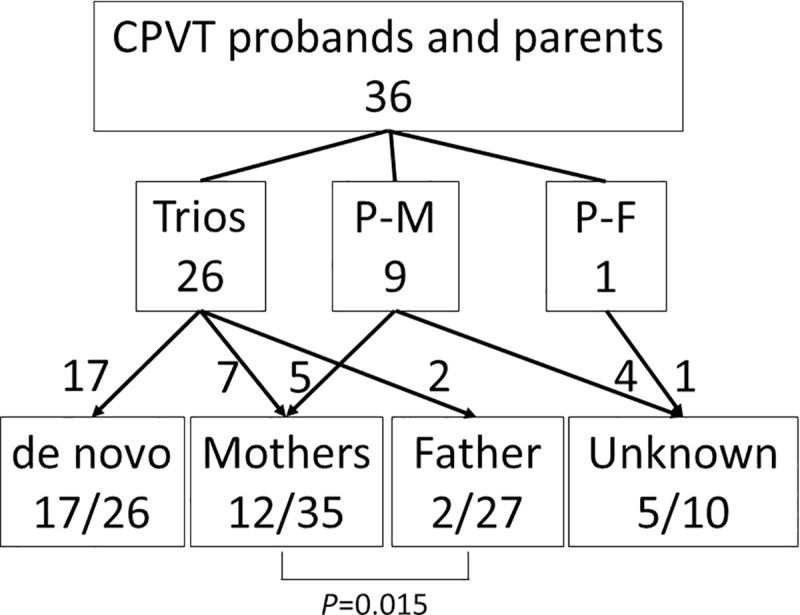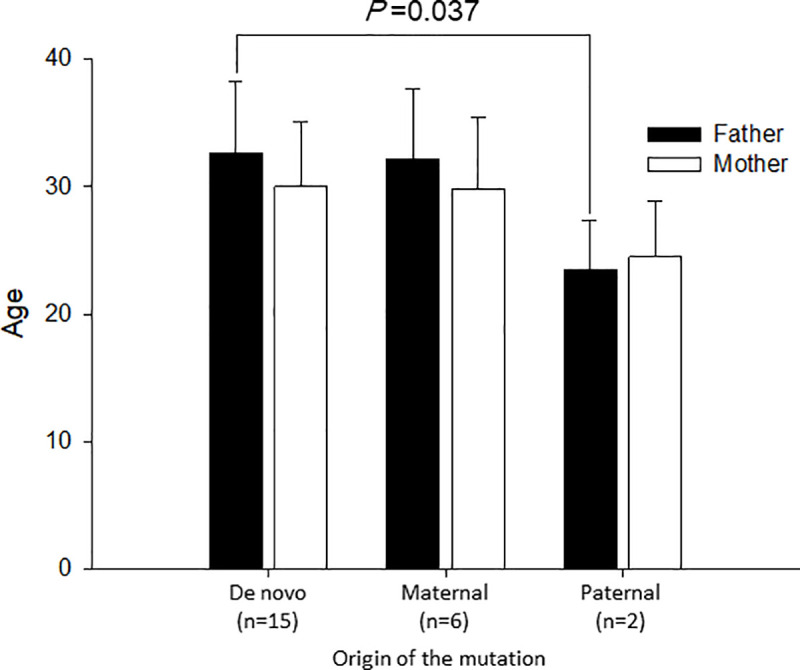In the Abstract, there is an error in the sixth sentence. The correct sentence is: The inheritance of RYR2 mutations was significantly more frequent from mothers (n = 12, 34.3%) than fathers (n = 2, 7.4%) (P = 0.015). In the Origin of the mutations subsection of the Results, there is a similar error in the second sentence of the second paragraph. The correct sentence is: The frequency of mutations originating from mothers was significantly higher than that from fathers (P = 0.015).
There are several errors in the Location of mutations subsection of the Results. The correct paragraph is: Among 12 mutations inherited from mothers, seven (58.3%) were located in the N-terminus, while only four (23.5%) from 17 de novo mutations were located in the N-terminus (Table 1). Regarding four de novo N-terminal mutations, three were at residue 169. In contrast, two maternal mutations (16.7%) were located in the central domain and two (16.7%) were located in the C-terminus. One mother carried two mutations in the Central and C-terminus.
Table 1. Clinical and genetic summaries of probands.
| Patient Number | Sex | Age | Most severe symptom | RYR2 mutation | Genotyped Family Members | Inheritance | Phenotype of parents | ||||
|---|---|---|---|---|---|---|---|---|---|---|---|
| Genetic Analysis | Onset | Nucleotide | Amino Acids | Location | |||||||
| Father | Mother | ||||||||||
| 1 | F | 17 | 16 | syncope | exon 3 deletion | N57_G91del35 | NT | Trio | Maternal | none | AF |
| 2 | F | 11 | 9 | syncope | exon 3 deletion | N57_G91del35 | NT | P-M | Maternal | none | syncope |
| 3 | F | 9 | 9 | syncope | 506g>t | R169L | NT | Trio | de novo | none | none |
| 4 | F | 5 | 5 | CPA | 506g>a | R169Q | NT | Trio | de novo | none | none |
| 5 | F | 9 | 8 | CPA | 506g>a | R169Q | NT | Trio | de novo | none | none |
| 6 | M | 16 | 12 | CPA | 533g>c | G178A | NT | Trio | de novo | none | none |
| 7 | M | 13 | 11 | syncope | 1221a>t | R407S | NT | P-M | de novo or F | none | none |
| 8 | F | 12 | 7 | CPA | 1259g>a | R420Q | NT | P-M | Maternal | none | syncope |
| 9 | M | 3 | 3 | syncope | 3667a>g | T1223A | NT | Trio | Maternal | none | none |
| 10 | F | 11 | 5 | syncope | 3766c>a | P1256T | NT | Trio | Maternal | none | none |
| 11 | F | 15 | 12 | syncope | 4552c>t | L1518F | NT | Trio | Maternal | none | none |
| 12 | F | 25 | 10 | syncope | 5170g>a | E1724K | NT | P-M | Maternal | none | syncope |
| 13 | M | 13 | 13 | CPA | 6574a>t | M2192L | Central | Trio | Maternal | none | none |
| 14 | M | 13 | 13 | CPA | 6737c>t | S2246L | Central | Trio | de novo | none | none |
| 15 | M | 14 | 11 | syncope | 7024g>a | G2342R | Central | Trio | Paternal (mosaic) | none | none |
| 16 | M | 11 | 10 | CPA | 7169c>t | T2390I | Central | Trio | Paternal | none | none |
| 17 | M | 15 | 10 | CPA | 7199g>t | G2400V | Central | Trio | de novo | none | none |
| 18 | M | 12 | 12 | CPA | 7423g>t | V2475F | Central | P-M | de novo or P | none | none |
| 19 | F | 18 | 8 | CPA | 11583g>c | Q3861H | Central | Trio | de novo | none | none |
| 20 | F | 8 | 8 | syncope | 11583g>t | Q3861H | Central | Trio | de novo | none | none |
| 21 | F | 27 | 6 | syncope | 11836g>a | G3946S | Central | P-M | de novo or P | none | none |
| 22 | F | 16 | 6 | syncope | 11836g>a | G3946S | Central | Trio | de novo | none | none |
| 23 | F | 28 | 28 | CPA | 11917g>a | D3973N | Central | Trio | Maternal | none | none |
| 24 | M | 3 | 3 | syncope | 12006g>a | M4002I | Central | Trio | de novo | none | none |
| 25 | M | 11 | 9 | syncope | 12371 g>a | S4124N | CT | P-M | Maternal | none | none |
| 26 | M | 11 | 11 | CPA | 12458g>t | S4153I | CT | P-F | de novo or M | none | SD |
| 27 | M | 11 | 2 | syncope | 12533a>g | N4178S | CT | Trio | de novo | none | none |
| 28 | F | 6 | 6 | CPA | 12579c>g | C4193W | CT | Trio | de novo | none | none |
| 29 | M | 10 | 10 | syncope | 13463a>c | Q4488P | CT | Trio | de novo | none | none |
| 30 | F | 33 | 9 | syncope | 13798t>c | F4600L | CT | Trio | de novo | none | none |
| 31 | M | 28 | 10 | syncope | 14174a>g | Y4725C | CT | Trio | de novo | none | none |
| 32 | F | 23 | 9 | syncope | 14311g>a | V4771I | CT | P-M | Maternal | none | syncope |
| 33 | M | 13 | 13 | CPA | 14311g>a | V4771I | CT | P-M | de novo or P | none | none |
| 34 | M | 17 | 14 | CPA | 14806c>a | Q4936K | CT | Trio | de novo | none | none |
| 35 | M | 5 | 5 | CPA | 14834_14835insTCA | 4944_4945insH | CT | Trio | de novo | none | none |
| 36 | M | 12 | 12 | CPA | 9910c>g, 14222c>t | Q3304E, A4741V | Central and CT | Trio | Maternal | none | syncope |
CPA; cardiac pulmonary arrest, NT; N-terminal, CT; C-terminal, SD; sudden death
In the Ages of parents at birth of probands subsection of the Results, the P value of the age difference in fathers between de novo and paternal is incorrectly reported as 0.019. The correct P value is 0.037.
There are errors in Table 1 and Table 2. Please see the correct tables here.
Table 2. Clinical characteristics of probands with de novo or maternal mutations.
| de novo | Maternal | |
|---|---|---|
| n = 17 | n = 12 | |
| Male n (%) | 9 (52.9) | 4 (33.3) |
| Mean age of Onset | 8.1±3.3 | 11.0±6.4 |
| CPA n (%) | 9 (52.9) | 4 (33.3) |
| Syncope n (%) | 8 (47.1) | 8 (66.7) |
There are errors in Fig 1 and Fig 3. Please see the correct figures here.
Fig 1. Scheme for Mutation Inheritance.

Showing the number of screened family members and the origin of RYR2 mutations. The boxes in the middle lane show genotyped family members in each group. Trio; proband and both parents, P-M; proband and mother, P-F; Proband and father.
Fig 3. Mean Age of parents depends on the RYR2 mutation origin.

Bar graphs depict mean ages of parents at the birth of probands. Filled bars indicate those of fathers and open bars those of mothers. The mean age of genotype-positive fathers was significantly younger than that of the de novo mutation group.
Reference
- 1.Ohno S, Hasegawa K, Horie M (2015) Gender Differences in the Inheritance Mode of RYR2 Mutations in Catecholaminergic Polymorphic Ventricular Tachycardia Patients. PLoS ONE 10(6): e0131517 10.1371/journal.pone.0131517 [DOI] [PMC free article] [PubMed] [Google Scholar]


